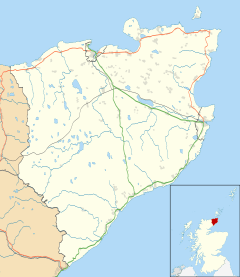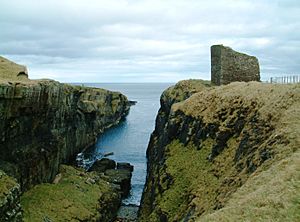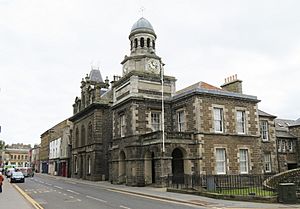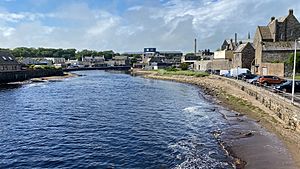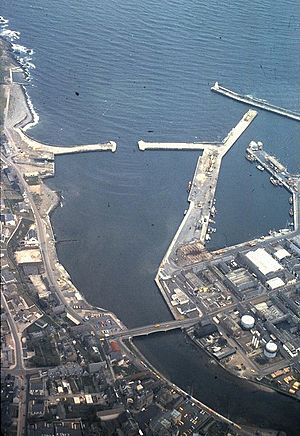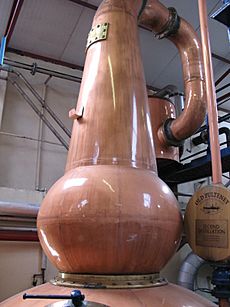Wick, Caithness facts for kids
Quick facts for kids Wick
|
|
|---|---|
 Looking down-river towards the Bridge of Wick |
|
| Area | 3.48 km2 (1.34 sq mi) |
| Population | 6,870 (2020) |
| • Density | 1,974/km2 (5,110/sq mi) |
| OS grid reference | ND365505 |
| • Edinburgh | 172 mi (277 km) |
| • London | 493 mi (793 km) |
| Council area | |
| Lieutenancy area | |
| Country | Scotland |
| Sovereign state | United Kingdom |
| Post town | WICK |
| Postcode district | KW1 |
| Dialling code | 01955 |
| Police | Northern |
| Fire | Highlands and Islands |
| Ambulance | Scottish |
| EU Parliament | Scotland |
| UK Parliament |
|
| Scottish Parliament |
|
Wick (Scottish Gaelic: Inbhir Ùige [ˈinivɪɾʲˈuːkʲə]; Scots: Week) is a town and royal burgh in Caithness, a region in the far north of Scotland. The town is built around the River Wick and stretches along both sides of Wick Bay. In 2011, about 6,954 people lived in the "Wick Locality".
Pulteneytown, a part of Wick on the south side of the river, was built in the 1800s by the British Fisheries Society. It became an official part of Wick in 1902.
Wick is located on the main road (the A99–A9 road) that connects John o' Groats with southern Britain. The Far North railway line also links Wick railway station to southern Scotland and to Thurso, another town in Caithness. Wick Airport is just outside Wick and is used for helicopter flights to offshore wind and oil projects. It also has regular flights to Aberdeen.
Wick is home to the main offices of two local newspapers, The John O'Groat Journal and The Caithness Courier. You can also find Caithness General Hospital (run by NHS Highland), the Wick Carnegie Library, and local offices for the Highland Council here. The Wick Sheriff Court is one of the courts that serves the Grampian, Highland, and Islands area.
Contents
Wick's Long History
Early Times in Wick
People lived and worked in the Wick area during the Iron Age. You can still see an old hill fort at Garrywhin. We know that Norse people were here too. In 1837, archaeologists found brooches and bracelets from their time. The name Wick comes from a Norse word, vík, which means bay. This is also where the word viking comes from.
The Arrival of Christianity
In the 700s, Saint Fergus, a missionary from Ireland, lived near Wick. He helped bring Christianity to the people there and is now the patron saint of Wick. One of the town's fairs, the Fergusmas, is named after him. It's also thought that the Chapel of St. Tear, near Ackergill, was built around the same time by St Drostan.
Wick in the 1100s and 1200s
Wick, along with all of Caithness, was part of Norway for a long time. This changed during the rule of William the Lion (1165–1214), when the Norwegian earls also became loyal to the Scottish king.
The Castle of Old Wick, often called "The Old Man of Wick," was likely built around 1160. It was built by Harald Maddadson, who was the Earl of Caithness and Orkney. Earl Harald, who was half Norse, probably lived there. Fishermen used it for many years to help them navigate the North Sea.
Wick in the 1300s and 1400s
Around 1330, the land around Wick was owned by the Cheyne family. The last male heir died around 1345. His two daughters then married into the Sinclair, Sutherland, and Keith families, who then took over the lands.
Between 1390 and 1406, King Robert III gave the town of Wick to Neill Sutherland. This made Wick a Burgh of Barony, which gave it special rights.
In 1438, the Gunn and Keith clans fought a battle near Wick. Both sides lost many people.
Wick in the 1500s
In 1503, the Scottish Parliament decided that a sheriff for Caithness should have an office in Wick.
In 1588, Wick suffered when Alexander Gordon, the Earl of Sutherland, attacked the town. He was fighting against the Sinclair Earl of Caithness. While the Sinclairs hid in Girnigoe Castle, Sutherland burned down Wick. At that time, Wick was mostly small houses with straw roofs. Everything except the church was burned.
In 1589, King James VI made Wick a royal burgh. This was a special status for the town.
Wick in the 1600s
Wick also saw some trouble during the Reformation. In 1613, a priest named Richard Merchiston angered the local people. He broke a stone statue of St. Fergus, Wick's patron saint. A group of townspeople then drowned him in the Wick River.
In 1680, the last clan battle in Scotland happened near Wick. It was a fight between the Campbell of Glenorcy and the Sinclairs. The Sinclairs were tricked into drinking too much whisky. The next morning, they were ambushed at Altimarlach. Many Sinclairs were pushed into the river and drowned.
Wick in the 1700s
In the 1700s, most people in Wick spoke Gaelic, but they could also understand English.
Every year on Innocents Day (December 28), people from Wick would gather at the ruins of the Chapel of St. Tear. They would leave offerings of bread, cheese, and money in the walls. A local dog-keeper would then take the food and feed it to his hounds.
Wick in the 1800s
In the late 1700s, the British Fishery Society started fishing ports in other places. But when herring moved away from the west coast, they looked to Wick. Building Wick Harbour began in 1803 and finished in 1811. It quickly became a busy port for fishing boats. As fishing grew, Wick became bigger and replaced Thurso as the main center for shipping and trade in Caithness.
In 1800, a bridge was built in Wick. Before that, people had to cross the river on a small footbridge. In 1811, a new road connecting Inverness to Thurso was completed, making travel easier. By 1818, a mail coach service connected Wick to southern Scotland.
Wick Baptist Church was started in 1806. Wick Town Hall was finished in 1828.
Pulteneytown was founded in 1808. It was built to give homes and work to many Scots who had been moved from their homes during the Highland Clearances. By the 1840s, over 1,000 herring boats used the harbor, and a large industry for curing fish grew up around it.
The Roman Catholic Church of St Joachim was built in 1836. It was the first Catholic church in Caithness since the Reformation. It served Irish workers who came for the herring season.
Two newspapers started in Wick in the 1800s: the John o' Groat Journal in 1836 and the Northern Ensign in 1850.
In 1868, author Robert Louis Stevenson stayed in Wick. His uncle, a lighthouse engineer, was working on the nearby Noss Head Lighthouse, which opened in 1869.
Wick in the 1900s
Captain Ernest Edmund "Ted" Fresson started the first air service in Wick in 1933. His company had scheduled flights between Inverness, Wick, and Kirkwall.
In 1939, the airfield became an RAF base. It was improved with runways and hangars. Pilots flying from Wick helped with scouting, anti-submarine patrols, and protecting convoys. The Lockheed Hudson plane was often used.
In May 1940, Wick was attacked often from the air. The first and most serious bombing was on July 1, 1940. A bomb hit Bank Row during the day when children were playing outside. This was the first daytime bombing in the UK. Fifteen people died, including eight children. Several buildings were destroyed or damaged.
Exploring Wick's Geography
The Wick River
The town sits at the mouth of the Wick River. Two road bridges cross the river. The Harbour Bridge connects Wick town center with Wick Harbour and Pulteneytown. Further upstream, the Bridge of Wick carries the main road that links John o' Groats with Latheron and Inverness.
Pulteneytown Area
Pulteneytown is now a part of Wick on the south side of the River Wick. Before 1902, it was managed separately from Wick.
Pulteneytown is named after Sir William Pulteney, 5th Baronet. He was a leader of the British Fisheries Society. In the early 1800s, Sir William asked Thomas Telford, a famous engineer, to design a new fishing town and harbor at the mouth of the River Wick.
Pulteneytown became very important during the 1800s herring boom. It was built to provide jobs for people who had been moved from their homes in the Highlands. The harbor was made even bigger by local shipbuilder James Bremner. You can learn about this time at the Wick Heritage Museum.
Pulteneytown had two main parts: Lower Pulteney, which was for work, and Upper Pulteney, which was for homes.
Pulteneytown Parish Church opened in 1842. It has been updated for today's churchgoers.
The Old Pulteney whisky distillery is in Pulteneytown. The first Caithness Glass factory was also here, but it has now moved away from Wick.
Wick Bay and Harbours
Wick Bay is shaped like a triangle. The river mouth is at the top point, and South Head and North Head are the two bottom points. These two points are about one kilometer apart. Beyond them is the North Sea.
Wick has three harbors: the Outer Harbour, the Inner Harbour, and the River Harbour. All are protected by strong walls called breakwaters. The Outer and Inner Harbours are on the south side of the river mouth. The River Harbour is on both sides of the river.
Wick Inner Harbour now has a large marina for leisure boats. It is a popular stop for people visiting by boat.
In 2012, a big storm damaged the harbor. In 2016, another storm broke a hole in the seawall.
Wick's Climate
Wick has an oceanic climate. This means it has a small temperature range, not much sunshine, and strong winds. Even though it's far north, it doesn't get a lot of rain. This is because mountains to the west create a "rain shadow."
| Climate data for Wick (WIC), elevation: 36 m or 118 ft, 1981–2010 normals, extremes 1930–present | |||||||||||||
|---|---|---|---|---|---|---|---|---|---|---|---|---|---|
| Month | Jan | Feb | Mar | Apr | May | Jun | Jul | Aug | Sep | Oct | Nov | Dec | Year |
| Record high °C (°F) | 13.0 (55.4) |
15.3 (59.5) |
19.9 (67.8) |
20.2 (68.4) |
22.0 (71.6) |
24.4 (75.9) |
25.6 (78.1) |
25.6 (78.1) |
23.9 (75.0) |
19.7 (67.5) |
16.7 (62.1) |
14.1 (57.4) |
25.6 (78.1) |
| Mean daily maximum °C (°F) | 6.2 (43.2) |
6.4 (43.5) |
7.8 (46.0) |
9.6 (49.3) |
11.8 (53.2) |
14.0 (57.2) |
16.0 (60.8) |
16.2 (61.2) |
14.4 (57.9) |
11.6 (52.9) |
8.6 (47.5) |
6.6 (43.9) |
10.8 (51.4) |
| Daily mean °C (°F) | 3.7 (38.7) |
3.8 (38.8) |
4.9 (40.8) |
6.6 (43.9) |
8.6 (47.5) |
11.0 (51.8) |
13.0 (55.4) |
13.2 (55.8) |
11.5 (52.7) |
9.0 (48.2) |
6.1 (43.0) |
4.0 (39.2) |
7.9 (46.2) |
| Mean daily minimum °C (°F) | 1.2 (34.2) |
1.1 (34.0) |
2.0 (35.6) |
3.5 (38.3) |
5.4 (41.7) |
7.9 (46.2) |
10.0 (50.0) |
10.1 (50.2) |
8.5 (47.3) |
6.3 (43.3) |
3.5 (38.3) |
1.4 (34.5) |
5.1 (41.2) |
| Record low °C (°F) | −11.1 (12.0) |
−13.9 (7.0) |
−10.5 (13.1) |
−7.1 (19.2) |
−3.9 (25.0) |
−1.1 (30.0) |
1.6 (34.9) |
0.5 (32.9) |
−2.0 (28.4) |
−6.1 (21.0) |
−10.8 (12.6) |
−11.7 (10.9) |
−13.9 (7.0) |
| Average precipitation mm (inches) | 72.3 (2.85) |
63.7 (2.51) |
66.5 (2.62) |
49.9 (1.96) |
48.6 (1.91) |
53.4 (2.10) |
61.5 (2.42) |
64.6 (2.54) |
73.7 (2.90) |
94.9 (3.74) |
90.1 (3.55) |
75.2 (2.96) |
814.3 (32.06) |
| Average precipitation days (≥ 1.0 mm) | 16.1 | 13.5 | 15.6 | 11.7 | 11.2 | 10.3 | 11.9 | 12.7 | 13.7 | 16.5 | 16.9 | 15.6 | 165.7 |
| Mean monthly sunshine hours | 48.0 | 70.7 | 110.8 | 138.1 | 189.1 | 152.9 | 136.2 | 134.9 | 116.2 | 92.3 | 54.9 | 35.7 | 1,279.6 |
| Source 1: Met Office | |||||||||||||
| Source 2: KNMI | |||||||||||||
How Wick is Governed
Wick has been a royal burgh since 1589, which means it has had special rights and a local government for a long time.
In 1975, Wick's local government became part of the Caithness district. Then, in 1996, the district was removed, and the Highland area became a single council area.
Since 2017, Wick has been part of a new local election area called Wick and East Caithness.
Wick is also within the old civil parish of Wick. This parish borders Latheron to the south, Watten and Bower to the west, and Canisbay to the north. The eastern border of the parish is the Moray Firth coastline.
Wick's Parliament History
Wick used to be a parliamentary burgh. This meant it joined with other towns like Dingwall and Kirkwall to elect one person to the House of Commons. This continued until 1918. After that, Wick became part of the larger county constituency of Caithness and Sutherland.
Wick's Economy and Businesses
Caithness Glass
A company that makes special glass was started in Wick in 1961. Over time, the production moved to Perth, and by 2004, all manufacturing had left Wick. Caithness Glass made the trophy for the BBC Mastermind TV show.
Old Pulteney Distillery
The Old Pulteney Distillery makes malt whisky in Pulteneytown. You can visit their center on Huddart Street. They make Old Pulteney Single Malt whisky of different ages. In 2012, their 21-year-old single malt was named World Whisky of the Year by expert Jim Murray.
Like Pulteneytown, the distillery is named after Sir William Pulteney, 5th Baronet. It opened in 1826 when Pulteneytown was a new fishing port. This distillery is the most northern on the Scottish mainland. When it first opened, it was hard to reach except by sea. Barley was brought in by sea, and the whisky was shipped out the same way. Many workers at the distillery were also fishermen. Old Pulteney is known as a Highland single malt Scotch.
The distillery is now owned by Inver House Distillers Limited.
Ignis Wick Ltd
Ignis Wick Ltd runs a heating system in Wick. It provides heat and hot water to almost 200 homes through underground pipes from a central boiler house. This company used to be called Caithness Heat and Power Limited (CHaP).
The council started this heating project. It was meant to use biomass (natural materials) to create both heat and electricity. However, the biomass plant didn't work as planned. So, they had to use fossil fuels for a longer time. In 2012, Ignis Biomass Ltd took over and installed a new plant that uses renewable energy. They plan to provide heat to even more homes.
Other Businesses
Wick is also home to the Shore Scottish Seaweed Company, which makes seaweed crisps. In July 2024, the company announced it would be growing its business.
Famous Landmarks in Wick
Castle of Old Wick
The Castle of Old Wick (58°25′24.09″N 3°4′53.91″W / 58.4233583°N 3.0816417°W) was built in the 1100s. At that time, Caithness was part of the Norwegian Earldom of Orkney. The castle was likely a strong base for Harald Maddadsson on the mainland. People lived on this site even before the castle was built.
Today, only a tall tower remains. It sits right on the edge of the cliffs, about half a mile south of Wick Bay. Originally, the castle had at least four stories and other buildings for workshops and living areas.
In the 1300s, it was owned by Sir Reginald de Cheyne. He supported Edward I in his efforts to make John Balliol King of Scotland. The castle was left empty in the 1700s.
Wick Heritage Museum
Wick Heritage Museum is in Bank Row, Pulteneytown. The Wick Society runs the museum. It focuses on the time when herring fishing was very important in Wick. The herring trade involved selling cured fish to other countries. It slowed down a lot after the First World War. The Johnston Collection, with about 50,000 images from 1863 to 1975, shows a great look into the town's history.
Wick Carnegie Library
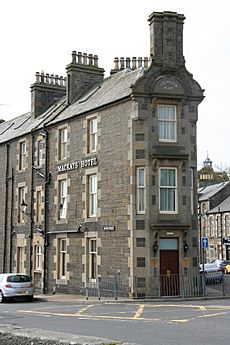
The Wick Carnegie Library is now run by the Highland Council. Besides offering a general library service, it keeps important books and documents about Wick and Caithness. It also has a crocodile (a Gavialis gangeticus) that was given to it in 1909.
The library building also holds the North Highland Archive and the St. Fergus Gallery. The North Highland Archive has official and private papers about Wick and Caithness, with the oldest dating back to 1589.
Andrew Carnegie helped pay for the library building, which was built in 1897. It is located where Sinclair Terrace and Cliff Road meet.
In February 2017, the Caithness county archives moved from Wick library to Nucleus, the Nuclear and Caithness Archives near Wick Airport. The Library is now also a Food Bank.
HMS Jervis Bay Memorial
In 2006, a memorial was put up to honor nine local sailors. They died in 1940 during a brave naval battle between their ship, HMS Jervis Bay, and the German ship Admiral Scheer.
Tourist Information Centre
The Tourist Information Centre is now on the second floor of Mcallan's store on High Street.
World's Shortest Street
In 2006, the BBC reported that the Guinness Book of Records confirmed the world's shortest street is Ebenezer Place (ND363508). It is only 2.06 meters long and has just one door.
Education in Wick
Wick has two primary schools, both run by the Highland Council: Noss Primary School and Newton Park Primary School. There is one secondary school in Wick, Wick High School. There used to be four primary schools, but North Primary and Hillhead Primary merged to form Noss Primary. South Primary and Pultneytown Academy merged to form Newton Park Primary.
Media in Wick
You can get television signals in Wick from the Rumster Forest or Keelylang Hill TV transmitters.
Local radio stations include BBC Radio Scotland (94.5 FM), BBC Radio Nan Gaidheal (for Gaelic speakers), MFR Radio (96.7 FM), and Caithness FM (106.5 FM), which is a community radio station.
The town is served by the local newspapers, John O'Groat Journal and Caithness Courier.
Sports in Wick
- Wick Academy F.C. plays in the Highland Football League.
- Wick Golf Club
- Wick Rovers F.C.
Wick on Film
There are old black and white, and color, films of Wick and the Highlands at the National Library of Scotland. You can watch the 1967 children's film The Hunch, which is set in Wick, online for free.
Twin Towns
For twenty years, Wick was twinned with Klaksvík in the Faroe Islands. In 2015, Wick councillors thought about ending this partnership. This was because of a long-standing practice in the Faroe Islands of hunting and eating migrating pilot whales. As of January 2016, the decision has been put off.
Notable People from Wick
- William Barclay, a theologian, born in Wick in 1907.
- John Barneson, a businessman, born in Wick in 1862.
- James Bremner (1784–1856), a famous Scottish naval architect, harbor builder, and ship-raiser.
- Henry Horne, 1st Baron Horne
- Charlotte McShane, a Scottish-born Australian triathlete.
- Ewan Morrison, an author and director.
- Evan Oliphant, a cyclist.
- Alexander Henry Rhind, an Egyptologist (1833–1863).
- Scott Sutherland, a sculptor.
- Fiona Claire Bruce, a Member of Parliament.
See also
 In Spanish: Wick (Escocia) para niños
In Spanish: Wick (Escocia) para niños


